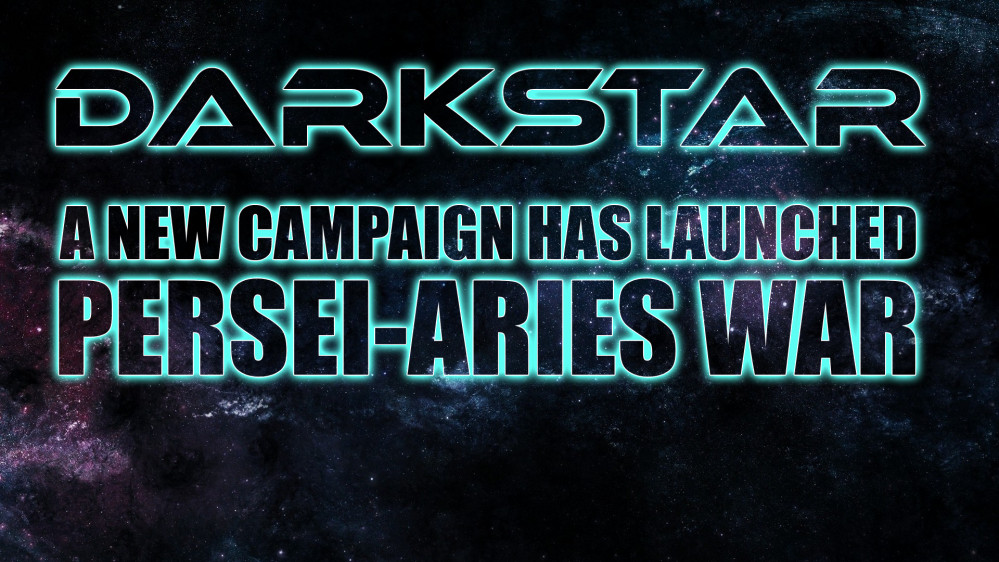
Persei-Aries War Resumes
Two More Factions out as Third Hercules War Builds to Climax
FROM: ADVISORY OFFICE, UN HERCULES SCS REGIONAL COLONIAL CENTER
02:15 SOL GMT, 26 MAY 2522
BREAKAUTH: 181072.18J
CLEARANCE: NATIONAL COMMAND AUTHORITY
SUBJ: SECOND BATTLE OF UXBRIDGE (Mu Hercules C-3)
By now even the most vapid colonial socialite among the colonies of the Hercules Rim can tell the war is drawing to a climax. Ever since the Americans were largely forced out of the Coalition of Eagles by the Treaty of Zubrin, the Russians have stood more or less alone against the Renkei Alliance (Britain, Japan, Arab League). The Corporate Consortium refuses to engage meaningfully. The New Roman Alliance, although a powerful (and fabulously wealthy) faction based out of their Catania colonies at Gliese 623, flails in a successive string of naval defeats.
All the while, the British (predominantly influenced by Lord Commodore Sir Edward Cavendish), have been aligning their Renkei allies for a final, war-winning strike on the Russians at 72 Hercules. To forestall this, the Russians have been creating as many problems along Renkei flanks and rear as possible. But by the end of May 2522, these “spoiling attacks” have run their course. A recent major Arab League victory has smashed the Russians out of their foothold at Khaizan’s Haven. The Russians and Romans were both defeated in a major battle at Avezzano in 99 Hercules, where a New Roman battleship Leo Magnus was beaten to within an inch of her life and driven off the table.
Now, in a final attempt to draw off pressure from 72 Hercules, the New Roman Alliance has mounted a small invasion of the British “Outer Hebrides” colonies at Mu Hercules. The Roman commander here, Commodore Justinian Pilaex, knows he can’t take the whole system, his mission is take just one planet, perhaps a few moons of one of the system’s outer ice giants, just enough to force the British to turn resources away from the impending invasion of Krasnaya Nadhezda.
However, opposition at Mu Hercules might be more than Pilaex anticipated. As per the “mutual military assistance” clauses of the recent Treaty of Zubrin, the Americans have been obligated to keep a task force at both the Outer Hebrides and the Hawking’s Star, defending these colonies of their former enemies. Now that a Roman task force has entered the outer debris belt of the Outer Hebrides, the Americans stationed there have orders to raise steam and intercept.
The force that will join battle is Task Force Oriskany under Captain Matthew Spencer, finally brought up to full strength now that the flagship, the Valcour class destroyer USS Oriskany, has completed her six-month “FRAM I” refit and upgrade at Port Halsey (Alpha Lyra / Vega). Together with the destroyers Valley Forge and Hancock (Captains Garrison Heathe and commander Priscilla Wolfe, respectively), the US Marine Corps light assault carrier USS Tarawa, (Captain Raymond Cruz) and the torpedo corvette USS Daggerfish (formerly Wolfe’s command, now under Lt. Commander Lewis Knight), Oriskany leads a light, fast, elite, and high-tech force. Grossly outmatched by the weight, gunnery, and power of Pilaex’s force, the Americans will have to use speed, upgraded electronics, and a vastly superior aerospace strike group to level the playing field.
Indeed, the sheer firepower of the Roman force is sobering. Pilaex’s flagship is the Tiberius class heavy cruiser Nicaea, 140,000 tons of high-tech EPCs, syglex emitters, and oversized engines that allow her to move like a ship two-thirds her size. Escorting her is the light cruiser Leclerc under Captain Raphael deChalemonde, the destroyer Corsica under Captain Daphne St. Croix, the light strike carrier Alejandra, and the torpedo corvette Sica.
The two task forces meet at the planet Ubridge (Paget’s Pride / Mu Hercules C-3), one of the major terrestrial worlds and colonial center for the British here at Mu Hercules (third planet of the third star of this trinary stellar group). Both sides have help coming in, the Romans have their invasion fleet, built around a Bersaglieri-class planetary assault ship, while the Americans have British forces coming in from the other side of the Mu Hercules system. Before either force arrives, however, the issue here will most likely be fatefully decided, one way or the other.
ASSAULT VICTORY CONDITIONS (429 points)
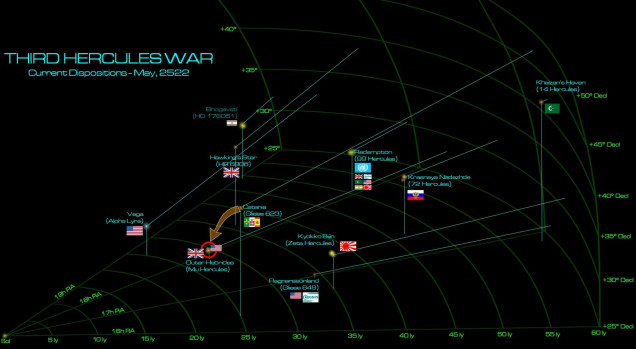 The general situation of the Third Hercules War in late May, 2522. For the Russians, holding out at their “Red Hope” colony (Krasnaya Nadhezda) at 72 Hercules, time is starting to run out. They’ve lost their foothold at Khaizan’s Haven, so the Arab League is again breathing down their neck from the outer rim. The British and Japanese have won a stark victory at Azzevano in 99 Hercules, largely shutting down the Roman and Russian bid to destabilize Anglo-Japanese rear areas as they build up against 72 Hercules. In a last bid to draw pressure from Krasnaya Nadhezda, the Romans have mounted a strike against the British at Mu Hercules.
The general situation of the Third Hercules War in late May, 2522. For the Russians, holding out at their “Red Hope” colony (Krasnaya Nadhezda) at 72 Hercules, time is starting to run out. They’ve lost their foothold at Khaizan’s Haven, so the Arab League is again breathing down their neck from the outer rim. The British and Japanese have won a stark victory at Azzevano in 99 Hercules, largely shutting down the Roman and Russian bid to destabilize Anglo-Japanese rear areas as they build up against 72 Hercules. In a last bid to draw pressure from Krasnaya Nadhezda, the Romans have mounted a strike against the British at Mu Hercules. 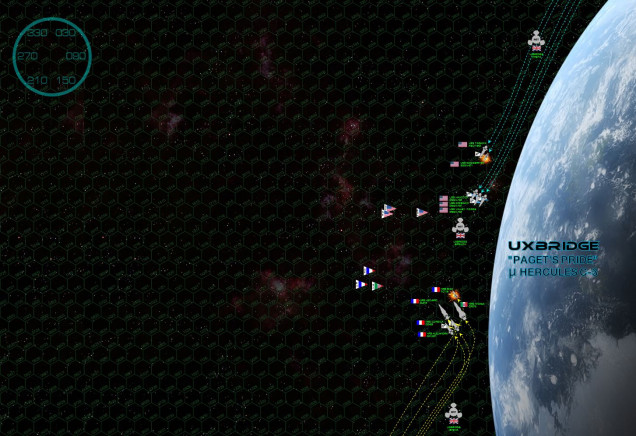 As the two task forces draw to engagement range over the day side of Uxbridge (Paget’s Pride), both sides hug the planet, anxious to secure the “gravity gauge” or even use the atmosphere to screen their more vulnerable engines and reactors. Romans come on fast, but the Americans come on even faster (only natural, as a destroyer flotilla they have MUCH more nimble ships). Initial gunfire is exchanged, already at just 1800 kilometers. The Roman flagship NRS Nicaea scores two hits on the torpedo corvette Daggerfish, while the light cruiser Leclerc scores one along with the destroyer Corsica. This opening volley hits the Daggerfish’s bridge, crippling the ship (Lt. Commander Lewis Knight survives). The American destroyers USS Oriskany, Valley Forge, and Hancock do the same to the torpedo corvette NRS Sica, the Oriskany finishing her off with a syglex emitter down the port side that hits the bridge, aft capacitors for mass drivers, portside reactor and engine housing. Lt. Commander Sebastian Anjou will also survive the day, but both corvettes are already blown out of the engagement.
As the two task forces draw to engagement range over the day side of Uxbridge (Paget’s Pride), both sides hug the planet, anxious to secure the “gravity gauge” or even use the atmosphere to screen their more vulnerable engines and reactors. Romans come on fast, but the Americans come on even faster (only natural, as a destroyer flotilla they have MUCH more nimble ships). Initial gunfire is exchanged, already at just 1800 kilometers. The Roman flagship NRS Nicaea scores two hits on the torpedo corvette Daggerfish, while the light cruiser Leclerc scores one along with the destroyer Corsica. This opening volley hits the Daggerfish’s bridge, crippling the ship (Lt. Commander Lewis Knight survives). The American destroyers USS Oriskany, Valley Forge, and Hancock do the same to the torpedo corvette NRS Sica, the Oriskany finishing her off with a syglex emitter down the port side that hits the bridge, aft capacitors for mass drivers, portside reactor and engine housing. Lt. Commander Sebastian Anjou will also survive the day, but both corvettes are already blown out of the engagement. The Americans largely lose the initiative, and Commodore Pilaex uses planet Uxbridge to screen the sterns of his ships. In response, Captain Spencer tries to bypass the Romans, then turn into a shallow dive toward the planet, THEN hairpin turn away to set up some kind of a broadside. His ships all have enhanced engines so they can JUST pull off the maneuver, but the results are not great ... they can’t target the port quarters of the of the Nicaea or the Leclerc. The Tarawa more or less has to flee the immediate battle area, making a starboard turn away from the planet and raising maximum steam to put as much distance between her and enemy guns. In all, it’s a bad movement phase, the Americans have to hope their larger ordinance strike and heavily-upgraded shielding can “brute force” their way through the difficult turn. DeChalemonde’s light cruiser NRS Leclerc fires her forward rail guns at the fleeing Tarawa, putting the rest of her broadside into the Oriskany, just 540 kilometers away. Yet even as the Lady O’s newly-upgraded shields reel under the lasers and rail guns, Leclerc is hammered by the combined Mark 48 gravitic torpedo spreads of all the American warships, plus the US Marine Corps’ VMF/A-319 (The Tigersharks) launched off the USS Tarawa. Despite a withering hail of accurate Roman point-defense, enough American torpedoes are guided by enhanced electronic warfare suites ... and the double-elite “Tigershark” Marines land just enough ASM-56 Harpoon torpedoes and ASM-92 Hellfire missiles ... to detonate the Leclerc’s starboard engineering suites, sending her crippled hulk spinning through space. Two Dassault-Rafale "Lancea" ship-to-ship torpedoes hit the stern of the carrier Tarawa, the rest of the Roman aerospace and torpedo strike pinging off Tarawa’s double-enhanced, EW-upgraded stern shields. The move costs two Roman Caproni CA.580 “Aquila” (Eagle) bombers, shot down by the Marine scouts. Forward EPCs of the Nicaea follow up, scoring one more hit which is finally enough to put the Tarawa out of action.
The Americans largely lose the initiative, and Commodore Pilaex uses planet Uxbridge to screen the sterns of his ships. In response, Captain Spencer tries to bypass the Romans, then turn into a shallow dive toward the planet, THEN hairpin turn away to set up some kind of a broadside. His ships all have enhanced engines so they can JUST pull off the maneuver, but the results are not great ... they can’t target the port quarters of the of the Nicaea or the Leclerc. The Tarawa more or less has to flee the immediate battle area, making a starboard turn away from the planet and raising maximum steam to put as much distance between her and enemy guns. In all, it’s a bad movement phase, the Americans have to hope their larger ordinance strike and heavily-upgraded shielding can “brute force” their way through the difficult turn. DeChalemonde’s light cruiser NRS Leclerc fires her forward rail guns at the fleeing Tarawa, putting the rest of her broadside into the Oriskany, just 540 kilometers away. Yet even as the Lady O’s newly-upgraded shields reel under the lasers and rail guns, Leclerc is hammered by the combined Mark 48 gravitic torpedo spreads of all the American warships, plus the US Marine Corps’ VMF/A-319 (The Tigersharks) launched off the USS Tarawa. Despite a withering hail of accurate Roman point-defense, enough American torpedoes are guided by enhanced electronic warfare suites ... and the double-elite “Tigershark” Marines land just enough ASM-56 Harpoon torpedoes and ASM-92 Hellfire missiles ... to detonate the Leclerc’s starboard engineering suites, sending her crippled hulk spinning through space. Two Dassault-Rafale "Lancea" ship-to-ship torpedoes hit the stern of the carrier Tarawa, the rest of the Roman aerospace and torpedo strike pinging off Tarawa’s double-enhanced, EW-upgraded stern shields. The move costs two Roman Caproni CA.580 “Aquila” (Eagle) bombers, shot down by the Marine scouts. Forward EPCs of the Nicaea follow up, scoring one more hit which is finally enough to put the Tarawa out of action. 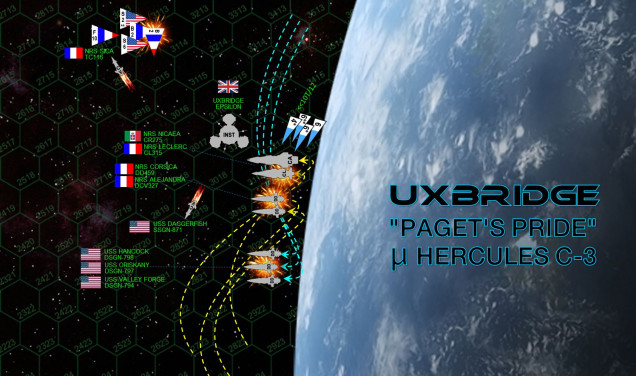 The rest of the Nicaea’s guns all fire at the Oriskany, and despite the close range and enhanced Roman targeting, ALL GUNS MISS (seriously, her d10 odds were base 10 + 2 for CIC, -7 for Oriskany’s absurd shielding = 5 modified to hit, remaining five shots were 6, 6, 7, 7, 7). The Leclerc has already done terrible damage, however (one 7 GW rail gun slammed right into the starboard engine, a second round hit in the same place and detonated actually INSIDE the port engine room). Even now, the Oriskany can survive. The Valley Forge and Hancock open fire into the port quarter of the destroyer Corsica (Captain Daphne St. Croix) at just 360 kilometers (2 hexes), hammering her open but not crippling her fast enough to prevent Corsica from swiveling her broadside on the Oriskany. Both the St. Croix’s Corsica and Spencer’s Oriskany (each a celebrated destroyer in their own right), limping and afire, put their last broadsides into each other. Corsica is positively ravaged, the remains of her stern basically blown off by Oriskany’s rail guns and brand new 75 eHz syglex emitters (even the carrier Alejandra takes a few hits). The Corsica’s 8 MgKv lasers likewise slash into the Oriskany, who just BARELY misses her Resolute Crew checks. and then the Romans just BARELY make the cripple check (needed a 2+ on d6, scored a d6. The Lady O is down.
The rest of the Nicaea’s guns all fire at the Oriskany, and despite the close range and enhanced Roman targeting, ALL GUNS MISS (seriously, her d10 odds were base 10 + 2 for CIC, -7 for Oriskany’s absurd shielding = 5 modified to hit, remaining five shots were 6, 6, 7, 7, 7). The Leclerc has already done terrible damage, however (one 7 GW rail gun slammed right into the starboard engine, a second round hit in the same place and detonated actually INSIDE the port engine room). Even now, the Oriskany can survive. The Valley Forge and Hancock open fire into the port quarter of the destroyer Corsica (Captain Daphne St. Croix) at just 360 kilometers (2 hexes), hammering her open but not crippling her fast enough to prevent Corsica from swiveling her broadside on the Oriskany. Both the St. Croix’s Corsica and Spencer’s Oriskany (each a celebrated destroyer in their own right), limping and afire, put their last broadsides into each other. Corsica is positively ravaged, the remains of her stern basically blown off by Oriskany’s rail guns and brand new 75 eHz syglex emitters (even the carrier Alejandra takes a few hits). The Corsica’s 8 MgKv lasers likewise slash into the Oriskany, who just BARELY misses her Resolute Crew checks. and then the Romans just BARELY make the cripple check (needed a 2+ on d6, scored a d6. The Lady O is down. 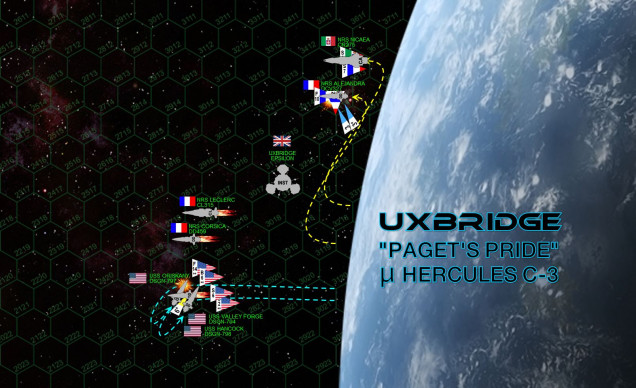 Left with only a ponderous heavy cruiser and a light carrier with no guns left in their task force, the Romans “take root” in low orbit of Uxbridge, jackknife-turning away from the Americans, keeping their sterns screened by the planet’s atmosphere. The Americans for their part (now just the destroyers Valley Forge and Hancock, Captain Garrison Heathe in command) pull away from the planet, hairpin turning back toward the Romans so they can launch full frontal torpedo spreads at the enemy (while keeping out of the Nicaea’s broadside). Frontal American guns ping away at the port bow or the carrier Alejandra, while the forward guns of the Nicaea hammer on the foc’s’le of the Valley Forge. The guns are hideously accurate, and the Valley Force loses her forward shields. This will hamper Heathe’s plan on keeping his bows pointing at the enemy for maximum torpedo attacks.
Left with only a ponderous heavy cruiser and a light carrier with no guns left in their task force, the Romans “take root” in low orbit of Uxbridge, jackknife-turning away from the Americans, keeping their sterns screened by the planet’s atmosphere. The Americans for their part (now just the destroyers Valley Forge and Hancock, Captain Garrison Heathe in command) pull away from the planet, hairpin turning back toward the Romans so they can launch full frontal torpedo spreads at the enemy (while keeping out of the Nicaea’s broadside). Frontal American guns ping away at the port bow or the carrier Alejandra, while the forward guns of the Nicaea hammer on the foc’s’le of the Valley Forge. The guns are hideously accurate, and the Valley Force loses her forward shields. This will hamper Heathe’s plan on keeping his bows pointing at the enemy for maximum torpedo attacks.  The Romans continue to “sideslip” along the upper atmosphere of Uxbridge, except this time Commodore Pilaex tries to keep more of Nicaea’s broadside threatening a wider arc of possible American approach space. The carrier Alejandra also rolls, keeping her port side screened from further American attacks. It doesn’t work, with the Americans sending their full torpedo wave and all the fighters and scouts of the Marine “Tigershark” squadron. Roman Dassault-Rafael “Mirage XII” fighters race back to defend their carrier, but their close enough to the American carriers to actually draw American mass driver fire. One Mirage is shot down. Pileax has a tough decision to make here, he can either engage the Marine fighters (F/S-44 Star Corsairs) with his mass drivers and lose the Alejandra to American torpedo attack, or shoot down the torpedoes and POSSIBLY lose the Alejandra to American fighters strafing the Alejandra’s bridge. He goes for the fighters, figuring me might as well make the Americans pay for his light carrier. The slaughter is horrific, 12 of the 14 Tigershark Corsairs are shot down as Pilaex more of less sacrifices the Alejandra. With no mass drivers defending the carrier, the Mirages originally send against Marine Corsairs instead switch to incoming torpedoes. Only three torpedoes are shot down, however, and five get through Alejandra’s aft shields. With torpedoes exploding in her engine rooms, the last two Marine Corsairs and eight Marine and Navy E/S-101 “Hawkeye” scouts make a desperate strafing run, one of the last Marine Corsairs shooting into Alejandra’s exposed starboard reactor room to finally cripple the ship. This bloodbath assault was costly, but the Marines can take solace in two more “Aquila” bombers were in Alejandra’s hangar bays (having landed to rearm). The Valley Forge and Hancock fire broadsides into the Nicaea, but the guns of two American destroyers against a 140,000 ton heavy cruiser isn’t going to do very much. They are positioned to fire full frontal spreads, however, using the drifting hulks of the Leclerc and the Corsica as initial target acquisition. The Nicaea’s aft guns hammer hard on the Valley Forge, this time hitting her on the starboard quarter, and ALMOST power her down (they needed a 6+, they rolled a 5). Damn, the Romans came within a single digit on the dice of winning the game right there.
The Romans continue to “sideslip” along the upper atmosphere of Uxbridge, except this time Commodore Pilaex tries to keep more of Nicaea’s broadside threatening a wider arc of possible American approach space. The carrier Alejandra also rolls, keeping her port side screened from further American attacks. It doesn’t work, with the Americans sending their full torpedo wave and all the fighters and scouts of the Marine “Tigershark” squadron. Roman Dassault-Rafael “Mirage XII” fighters race back to defend their carrier, but their close enough to the American carriers to actually draw American mass driver fire. One Mirage is shot down. Pileax has a tough decision to make here, he can either engage the Marine fighters (F/S-44 Star Corsairs) with his mass drivers and lose the Alejandra to American torpedo attack, or shoot down the torpedoes and POSSIBLY lose the Alejandra to American fighters strafing the Alejandra’s bridge. He goes for the fighters, figuring me might as well make the Americans pay for his light carrier. The slaughter is horrific, 12 of the 14 Tigershark Corsairs are shot down as Pilaex more of less sacrifices the Alejandra. With no mass drivers defending the carrier, the Mirages originally send against Marine Corsairs instead switch to incoming torpedoes. Only three torpedoes are shot down, however, and five get through Alejandra’s aft shields. With torpedoes exploding in her engine rooms, the last two Marine Corsairs and eight Marine and Navy E/S-101 “Hawkeye” scouts make a desperate strafing run, one of the last Marine Corsairs shooting into Alejandra’s exposed starboard reactor room to finally cripple the ship. This bloodbath assault was costly, but the Marines can take solace in two more “Aquila” bombers were in Alejandra’s hangar bays (having landed to rearm). The Valley Forge and Hancock fire broadsides into the Nicaea, but the guns of two American destroyers against a 140,000 ton heavy cruiser isn’t going to do very much. They are positioned to fire full frontal spreads, however, using the drifting hulks of the Leclerc and the Corsica as initial target acquisition. The Nicaea’s aft guns hammer hard on the Valley Forge, this time hitting her on the starboard quarter, and ALMOST power her down (they needed a 6+, they rolled a 5). Damn, the Romans came within a single digit on the dice of winning the game right there.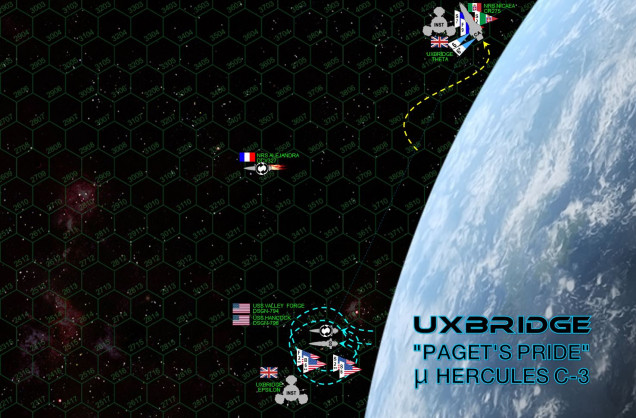 The battle is now reaching a frustrating draw. The Nicaea continues to sideslip, the Americans tucking back further and further behind the curvature of the planet. Nicaea’s guns are absurdly powerful and accurate, but as long as she continues to use the planet to screen her stern, and the Americans hide behind the curvature of the planet, they can’t hit. In order to engage the Americans (who are now content to run out the clock), Nicaea has to raise stem, turn away from the planet, and come down after them. The problem here is that this puts the Nicaea’s stern in play from American torpedoes. The American hopes are on a last big torpedo smash on the Nicaea’s stern, while the Nicaea’s hope is to cripple or drive off the Valley Forge. But honestly Valley Forge can hide behind the planet, keep the range open, and keep presenting fresh armor and shields (admittedly she is pretty badly damaged by this point). The Americans are also keeping their remaining aerospace craft by their destroyers, so any Roman fighter attacks against them will be mown down before they attack the remaining fighters and bombers. The Roman fighters, meanwhile, are also hanging by the cruiser, ensuring that no American torpedoes really have a shot of getting through.
The battle is now reaching a frustrating draw. The Nicaea continues to sideslip, the Americans tucking back further and further behind the curvature of the planet. Nicaea’s guns are absurdly powerful and accurate, but as long as she continues to use the planet to screen her stern, and the Americans hide behind the curvature of the planet, they can’t hit. In order to engage the Americans (who are now content to run out the clock), Nicaea has to raise stem, turn away from the planet, and come down after them. The problem here is that this puts the Nicaea’s stern in play from American torpedoes. The American hopes are on a last big torpedo smash on the Nicaea’s stern, while the Nicaea’s hope is to cripple or drive off the Valley Forge. But honestly Valley Forge can hide behind the planet, keep the range open, and keep presenting fresh armor and shields (admittedly she is pretty badly damaged by this point). The Americans are also keeping their remaining aerospace craft by their destroyers, so any Roman fighter attacks against them will be mown down before they attack the remaining fighters and bombers. The Roman fighters, meanwhile, are also hanging by the cruiser, ensuring that no American torpedoes really have a shot of getting through.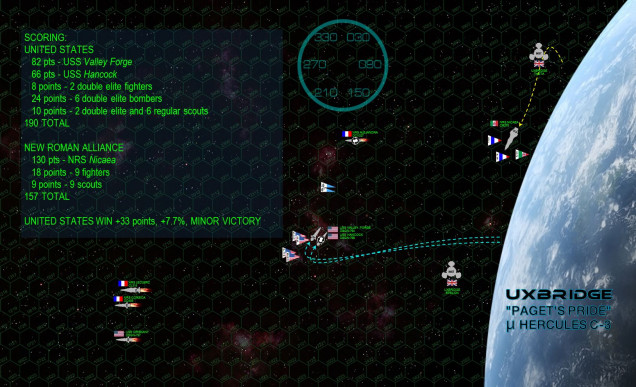 We call it on Turn 6. Neither side has any good options here. It’s not a very cinematic ending, I’m sorry to say, but the Americans have a slender lead here and have the option to run out the clock. They do so, and thus win by a razor-thin margin. Because this battle was so thin, and won largely through “run out the clock” cheese, I’ll count it only as half campaign points. Suffice it to say that Commodore Pilaex is still screaming for that invasion force to come in and land on Uxbridge, have JUST ENOUGH firepower to make his superior think twice about sending in troop ships (especially with British naval forces also expected to arrive within 12 hours). In short, it’s Assault victory conditions, whichever side has the most SURVIVING assets on the table (by points) at the end of Turn 8, wins.
We call it on Turn 6. Neither side has any good options here. It’s not a very cinematic ending, I’m sorry to say, but the Americans have a slender lead here and have the option to run out the clock. They do so, and thus win by a razor-thin margin. Because this battle was so thin, and won largely through “run out the clock” cheese, I’ll count it only as half campaign points. Suffice it to say that Commodore Pilaex is still screaming for that invasion force to come in and land on Uxbridge, have JUST ENOUGH firepower to make his superior think twice about sending in troop ships (especially with British naval forces also expected to arrive within 12 hours). In short, it’s Assault victory conditions, whichever side has the most SURVIVING assets on the table (by points) at the end of Turn 8, wins. 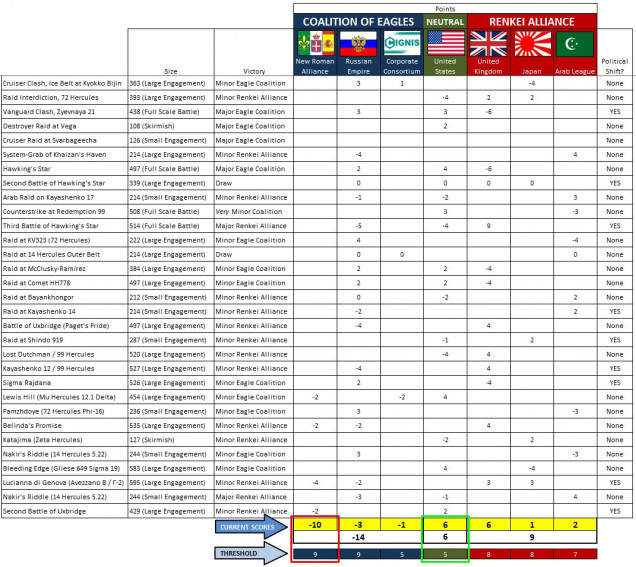 This ends the Third Hercules War for the Americans (cashing out as “winners”) but remember they also “lost” when they had to sign the Treaty of Zubrin with the British. So yes, the American bid to outright seize the Outer Hebrides or Hawking’s Star has failed. However, they’ve secured a valuable shipping lease with the British at the Lost Dutchman in the 99 Hercules System, a lease with the Consortium in Gliese 649 after their startling victory against the Japanese at Bleeding Edge, and rights to ship through a small gas giant moon in the Catania system after defeating the New Romans twice at Mu Hercules. As for the New Romans, the cardinals and princes who advocated entry into the Third Hercules War have been removed from power, once has even been exiled in disgrace. They came close a couple times, but honestly never won a single battle. With the Romans out of the war, the rear and flanks of any prospective Renkei Alliance assault (British, Japanese, and Arab League) on the Russian stronghold at 72 Hercules are now clear. After nearly two years (this campaign started 14 October 2520), the Third Hercules War might be finally drawing to a close.
This ends the Third Hercules War for the Americans (cashing out as “winners”) but remember they also “lost” when they had to sign the Treaty of Zubrin with the British. So yes, the American bid to outright seize the Outer Hebrides or Hawking’s Star has failed. However, they’ve secured a valuable shipping lease with the British at the Lost Dutchman in the 99 Hercules System, a lease with the Consortium in Gliese 649 after their startling victory against the Japanese at Bleeding Edge, and rights to ship through a small gas giant moon in the Catania system after defeating the New Romans twice at Mu Hercules. As for the New Romans, the cardinals and princes who advocated entry into the Third Hercules War have been removed from power, once has even been exiled in disgrace. They came close a couple times, but honestly never won a single battle. With the Romans out of the war, the rear and flanks of any prospective Renkei Alliance assault (British, Japanese, and Arab League) on the Russian stronghold at 72 Hercules are now clear. After nearly two years (this campaign started 14 October 2520), the Third Hercules War might be finally drawing to a close. 









































































Good news for the Renkei Alliance once more!
Classic colonial British tactic, @muakhah !
Get someone else to do as much of the fighting as possible. 😀
Just kidding. This was really a way for me to retire my Americans for now, clean up the table of extra factions, and get Third Hercules Campaign closer to a resolution (31 pitched battles and counting).
Shame the Japanese didn’t get a chance to take some Roman real estate in the Catania system before the Romans folded, that would have been good for the balance of power in the Renkei alliance.
So, we have one Caliphate and two British battlegroups ready to assault the Russians?
The Arabs and Japanese may have to negotiate how to share the spoils for the assault in to 72 Hercules if they want Japanese help to oust the Russians.
Thanks, @damon . However you guys want to handle the assault on 72 Hercules is cool with me. Two British fleets: That’s up to you and @gladesrunner . She’ll be out of town for a week or so, but should be back in time for any potential games next weekend. Yes, the Arab League is ready to go after @muakhah ‘s victory last week. @rasmus ‘ Japanese were also part of the victory at Avezzano, so per the campaign rules they are also lined up for an assault on the Russians. So we may be looking at a FOUR-task force… Read more »
@damon @rasmus
Happy to have more help seeing as the Arab League are not big players in this area!
I guess it’s up to what the Japanese want?
Do you want real estate or shopping rights etc?
I think it’s clear that the Arab league is beginning to place a higher importance on real estate closer to Earth. What do the Japanese want in this sector?
This is assuming the Russians don’t manage to salvage things and negotiate some sort of status quo peace. It’s highly probable I screw up the Arab league portion of the invasion!